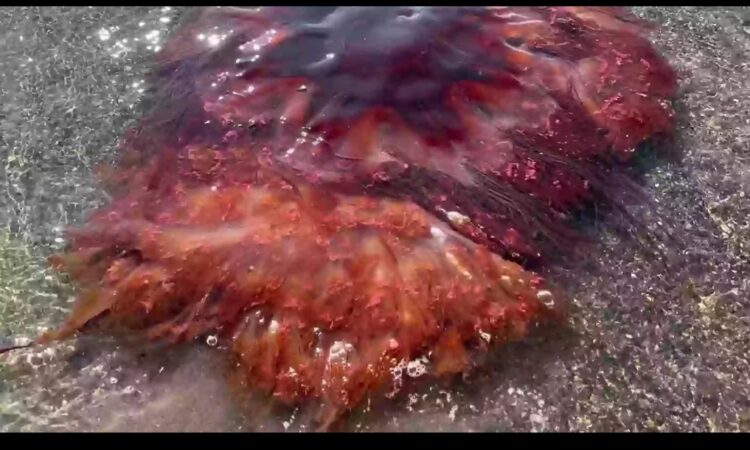
A giant, toxic jellyfish has washed up on the shores of a well-known beach in Maine, sparking concern among locals and tourists alike. Officials are warning everyone to stay cautious, especially because this isn’t an ordinary jellyfish—it belongs to a species known as the lion’s mane jellyfish, one of the longest animals in the world. Its tentacles can grow up to an astonishing 120 feet, making it even longer than a blue whale. To put that into perspective, that’s nearly the height of the Statue of Liberty. Though it doesn’t have the weight or size of a whale, its long, flowing tentacles are incredibly dangerous and can deliver a painful sting that most people would never forget.
Anyone who has ever been stung by a jellyfish, even a small one, knows how intense the pain can be. One person recalled being stung as a child and described it as a sharp, burning sensation that lasted long after the jellyfish had drifted away. The tentacles had wrapped around their arm, and even years later, they still remember the sting clearly. The idea of coming into contact with a lion’s mane jellyfish—something far larger and far more toxic—would terrify even the bravest beachgoers. In fact, if someone were to be stung by one of these massive creatures, the pain would likely be far worse, and the risk of serious injury would be much higher.
Recently, a jellyfish nearly five feet wide was discovered at Willard Beach in South Portland, Maine. City officials took to Facebook to alert the public. They urged people not to touch the jellyfish under any circumstances. They explained that while these animals are interesting to look at, they are not safe to handle. If spotted, people are encouraged to observe from a safe distance and inform a lifeguard. The lifeguards are trained to deal with the situation and will safely return the jellyfish to the water using a shovel. It’s not something that should be approached by anyone without proper training.
The increase in sightings has not gone unnoticed by scientists. Nicholas Record, a senior research scientist at the Bigelow Laboratory for Ocean Sciences, has been tracking jellyfish in the Gulf of Maine since 2014. He explained that the lion’s mane jellyfish is not new to these waters, as they are a sub-Arctic species. However, what’s surprising is the size and frequency of the ones being reported lately. In most years, the jellyfish people see are small—usually about the size of a dinner plate. But now, more and more reports are coming in of jellyfish that are two feet across, and even some that are five feet wide. That kind of growth is unusual and suggests that something in the ocean environment may be changing.
This sudden rise in jellyfish appearances has become a unique phenomenon along the Maine coast. While these creatures have always been present in the ocean, the number and size of lion’s mane jellyfish now being seen are far beyond the norm. It raises important questions about changes in ocean temperature, currents, and food sources that could be affecting marine life. For now, though, the most important thing is public safety.
Anyone spending time at the beach should stay alert and avoid touching any jellyfish, especially if it’s large and unfamiliar. Even after they’ve washed up on the shore and appear lifeless, jellyfish can still sting if their tentacles make contact with your skin. The safest thing to do is admire them from a distance, report the sighting to authorities, and allow professionals to handle the situation. The ocean may be full of beautiful and fascinating creatures, but it’s also filled with hidden dangers that shouldn’t be underestimated.




